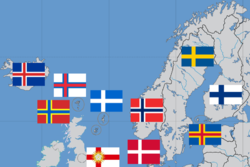Confusion over Scandinavian flags remains
among military collectors today - perhaps with good reason. Often the Danish
Dannebrog is confused with the Swiss flag, however the subtleties of
Scandinavian flags are quite simple - once clearly differentiated, that is.
Once among the world’s most powerful
nations, Denmark still ranks as one of the largest geographic countries on
earth; counting its protectorate, Greenland, plus the Faroe Islands and
Bornholm. While once ruling much of present day Norway and Sweden, Denmark has
made an even more lasting impression on world history with their flag, the
Dannebrog.
The basic design can be traced back
700 years, and a coin suggests it dates from the late 1100’s and could actually
be related to red flags used on the Baltic Sea in the ninth century. In a story
known to Danish children, the Dannebrog fell from heaven on June 15, 1219
during a battle at Lyndanisse between Denmark’s King Valdemar II and Estonia. Bishops
had of course prayed for victory, and as a sign of favor, God sent the first
Dannebrog fluttering down to earth.
More likely is that it was a gift
from the Pope, as it appears similar to the war flag of the Holy Roman
emperors, while other areas of Europe have employed a similar design through
history; Danzig, Barcelona, Pisa, Utrecht, and Savoy.
In its current form, the Dannebrog is
among the simplest in the world - a white cross offset on red. This design is
also employed by Norway but with an inset blue cross overlaying the white.
Sweden has a yellow cross on blue, and the Danish island of Bornholm keeps the
Dannebrog red field with an overlaid green cross. Though technically Iceland
and Finland are not considered part of Scandinavia, their flags are of the
basic Dannebrog design. Iceland with its red cross over white on a blue field,
Finland with the light blue cross on white. The Finnish province of Aaland
bears a red cross inset over a yellow cross on a blue field. The Danish Faroe
Islands flag bears a red cross inset on blue on a white field.
The Dannebrog is flown both in
rectangular form as well as the “splitflag,” which is reserved for royal
institutions and the navy. Of course any visit to beautiful Denmark will show
that Danes are practically unrivaled in their pride over the Dannebrog. It is
flown virtually anywhere there is room; at home, in the garden plot, strung
across shopping malls, around sitting rooms, atop birthday cakes, and even as
ornaments for Christmas trees. It is flown in commemoration of a glorious early
May day in 1945 when the occupying Germany army was forced out. Every July 4th,
many Danes also observe the American Independence day with the Dannebrog flying
next to the stars and stripes to celebrate the strong ties between the United
States and Denmark.
References: “Flags Through the Ages and Across the World,” by Dr. Whitney Smith; and
Tojhusmuset, Copenhagen.
Map image sourced from:
<http://upload.wikimedia.org/wikipedia/commons/thumb/6/6e/Nordic_flags.PNG/250px-Nordic_flags.PN>


No comments:
Post a Comment